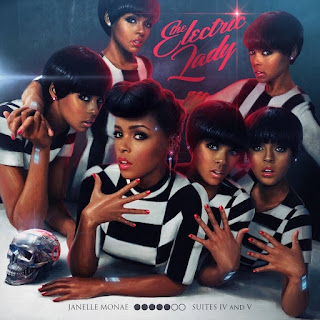[originally published in 2017]
With Janelle Monae gaining attention following their prominent role in Oscar favourite Hidden Figures, it is worth taking a look back at the work that brought them to prominence.
A Monae album is akin to a Russian doll — a variety of pop surfaces covering a nugget of something more profound. Their music is a unique blend of RnB, soul, dance, jazz and basically any other genre you can think of. This blend of influences serves as the vehicle for Monae’s fascination with science fiction, which itself is a conduit for exploring themes of gender, race and sexuality.
Monae’s music is based around telling the story of Cindi Mayweather, an android on the run for falling in love with a human. A metaphor for the ‘other’, Monae’s focus on androids acts as a stand-in for societal others — racial, sexual, class etc.
The Electric Lady is Monae's third album, following the 2003’s self produced effort The Audition, and the fourth and fifth parts in their Metropolis concept project (if anyone is interested in catching up on the previous chapters, check out their EP Metropolis: Suite I (The Chase) (2007) and 2010 album The ArchAndroid).
If that sounds like a lot to swallow, don’t worry. The great thing about Monae is that the music is extremely enjoyable. It’s like getting the key to the ear candy store. You might end up with cavities and a headache, but you’ll have a great time.
Opening with an overture that sounds like a cross between the theme between a spaghetti western and John Barry’s score to the sci fi flop The Black Hole (1979), The Electric Lady launches into ‘Givin Em What They Love’, a sweet groove featuring Monae’s idol Prince on vocals. Lifted by some some sanctified organ and a scintillating guitar solo from the Purple One, it sets the stage for the album perfectly.
Even better is ‘Q.U.E.E.N.’ a terrific anthem Monae shares with Erykah Badu. Highly danceable and oddly poignant in light of recent events, it is an ode to black femininity and sexual positivism. ‘Primetime’ is a duet with Miguel and plenty of plaintive guitar. ‘We Were Rock & Roll’ is psychedelic soul, complete with added sanctified call and response choruses. ‘Dance Apocalyptic’ is a duwop song by way of armageddon. ‘Look Into My Eyes’ is an old school torch song — and by old school, I mean it sounds like something you would hear Julie London or Sarah Vaughn toss off in 1961.
Signalled by another overture, the second half of the album continues Monae’s musical magpie adventures. ’It’s Code’ is a slow jam from the Seventies, with smooth production and light synth touches which recall Leon Ware’s productions for Marvin Gaye’s I Want You and his own Musical Massage. Monae’s stay in Seventies textures continues with the funky ‘Ghetto Woman’, which reaffirms the empowering mantra of ‘Q.U.E.E.N.’
The album does run out of steam a wee bit towards the end, aside from ‘Dorothy Dandridge’s Eyes’, another Ware-style slow jam (with a cameo from Esperanza Spalding) and an inspired use of shredding guitar on the fade-out.
Overall, The Electric Lady is a fantastic album and a great entry point for anyone looking to getting into Janelle Monae’s music. Hopefully Monae's success with Hidden Figures does not delay their next musical adventures.
If you are new to this blog, I also co-host a podcast on James Bond, The James Bond Cocktail Hour.
You can subscribe on iTunes, or wherever you get your podcasts.

No comments:
Post a Comment